高中英语强调句精讲精练 (1)
高中英语语法强调句讲解 (共24张PPT)

关于It is/was…that… 这个强调句型, 如果把“It is (was)...that ”去掉,还应该 是个完整的句子,不缺任何成分。
由as,since引导的原因状语从句(通常是 已知信息,不需强调)或though, although引导的让步状语从句一般不做被 强调部分。
区分下例两句:
A. didn’t B. did C. really D. would
4. It was the training _____ he had as a young man _____ made him such a good engineer.
A. what; that B. that; what C. that; which D. which; that
A. was B. are C. were D. had been
2. It was not until 1920 _____ regular radio broadcasts began.
A.which B. when C. that D. since
3. She said she would go and she ________ go.
He speaks English well. 这句话,可以通过语句重音来 分别对不同的词进行强调
Example:
A: We need a good student to host the evening party. B: Well, he speaks English well. A: He’s been living in Canada for years. B: He speaks English well but his writing is not very good.
2020备考高考语法--强调句 讲解与练习
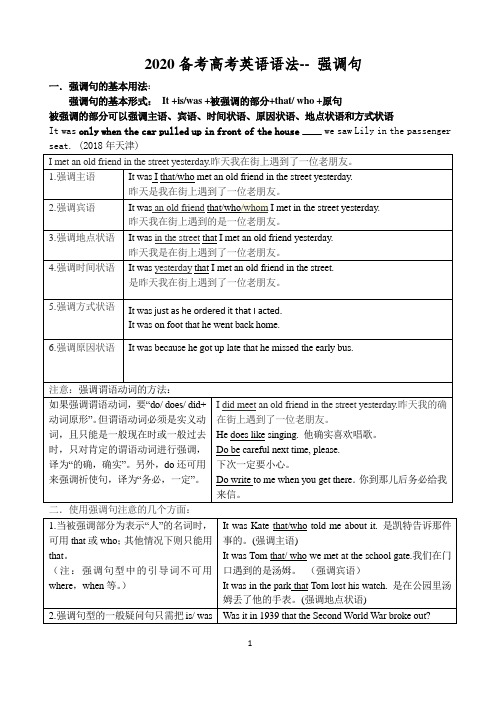
2020备考高考英语语法-- 强调句一.强调句的基本用法:强调句的基本形式:It +is/was +被强调的部分+that/ who +原句被强调的部分可以强调主语、宾语、时间状语、原因状语、地点状语和方式状语It was only when the car pulled up in front of the house____ we saw Lily in the passenger seat. (2018年天津)1.强调句与since、before 和when引导句型的区别1).It was/is+ (时刻,或时间点)+ when …..当某事发生时,是几点钟或哪一年如:It was 1997 when Hongkong returned to China.It was five o'clock when we arrived at the small mountain village.It was midnight when he got home.对比:It was at five o'clock ______ we arrived at the small mountain village.( that)2).It+ is/ was+…+that…多用于强调3).It was+一段时间+ before sb did sth. 过了一段时间之后,才….It will be +一段时间before sb do sth. 要过一段时间之后,才…..It won’t be long before sb do sth .不久之后就...It wasn’t long before sb did sth. 不久之后就…如:It was two years before Macao returned to China.It won’t be long before you see him again. 没过多久你就会再见到他。
高中英语语法基础 强调句型知识点归纳讲解(附同步练习)(有答案)

高中英语语法基础——强调句型知识点归纳讲解(附同步练习)在高中英语中,强调句是重点句型,也是难点句型,更是考试中的高频句型。
作为英语语言表达中一种句型,强调句的使用,目的在于通过强调主语、宾语或者是状语某个部分,来强化表述自己对一句话中某一个点(时间、地点、人物、事件等方面)的情感,态度和意愿。
强调句属于主从复合句,但强调部分只强调句子的某一个成分。
英语中常用的强调结构有:It is (was)+被强调部分(主语、宾语或状语)+that/who...(陈述句);疑问词what/how/why…+be it that…句型(疑问句);It was not until… + that…句型。
一)、陈述句强调句型(1)It is/was+被强调部分(通常是主语、宾语或状语)+that/who(当强调主语且主语指人)+从句。
如:原句:Mary did the experiment in the lab yesterday evening.强调主语:It was Mary who did the experiment in the lab yesterday evening.强调宾语:It was the experiment that Mary did in the lab yesterday evening.强调时间:It was yesterday evening that Mary did the experiment in the lab. (注意不用when)强调地点:It was in the lab that Mary did the experiment yesterday evening. (注意不用where)(2)强调谓语动词时,用助动词do/does或did。
如:Do remember to get up early tomorrow, or we will miss the train.Do be careful when you cross the street.He did write to you last week.Mr.White, I did hand in my homework to you this morning.二)、疑问句强调句型1、一般疑问句的强调句型:形式上只需将is / was提前,即:Is / Was+ it+被强调部分+that / who+从句? 如:Was it your brother that made you get hurt?Was it in Beihai Park that they made a date for the first time?2、特殊疑问句的强调句型:被强调部分(通常是疑问词Who / When / What / How / Where / Why...)+is / was+it+that+从句?如:原句:How did he come here ? 强调句:How was it that he came here ?原句:Why did he came late ? 强调句:Why was it that he came late ?原句:When / Where did you met your girlfriend for the first time ?强调句:When and where was it that you met your girlfriend for the first time ?三)、not...until...强调句型1、句型为:It is/was not until+被强调部分+that+从句。
高中英语语法专项——强调句讲解和练习题(含答案)

高中英语语法专项——强调句语法精讲1、固定公式:It is/was+被强调部分+that (who) + 原句剩余部分。
2、强调对象:主语、宾语、地点状语、时间状语等, (不能强调谓语)例: They broke the window in the street last night.①②③④例句中①是主语,②是宾语,③是地点状语,④是时间状语。
均可被强调。
3、一般疑问式:Is (或Was ) it + 被强调部分+ that +原句剩余部分?4、强调疑问词:疑问词+ is (或was) it + that + 加原句剩余部分?例:Who broke the window? →Who was it that broke the window? 5、强调宾语从句中的疑问词用陈述语序:例:He asked me who broke the window. →He asked me who it was that broke the window.6、强调not…until 结构要将not 和until 看作一个整体。
例:He didn’t understand his mother until she died.It was not until she died that he understood his mother.7、其它强调方式A.可用on earth, in the world 等词组强调疑问词以加强语气。
例:What on earth are you doing?B、可以用even, ever, indeed, really, terribly等副词强调句中的谓语动词以加强语气。
例:I really don’t know what has happened.It is cold outside indeed.C、可以在动词前加do以加强语气。
例:I do believe her.I did see the accident this morning.(强调过去)8、区别强调句型与主语从句可采用还原法。
[精编] 高中英语语法:强调句型 讲解及练习 高考英语强调句和倒装句及练习(附答案)
![[精编] 高中英语语法:强调句型 讲解及练习 高考英语强调句和倒装句及练习(附答案)](https://img.taocdn.com/s3/m/a49d06d2941ea76e58fa048b.png)
[精编] 高中英语语法:强调句型讲解及练习为了加强语气或引起听话人的重视,人们说话时会对某些部分强调。
英语中常见的表示强调的方式有以下三种:一、强调谓语动词可以在谓语动词前加do,does或did来强调此动作。
强调谓语动词时只有两种时态即: 一般现在时和一般过去时。
例如:二、强调除了谓语之外的其他句子成分通常使用强调句型来强调除了谓语之外的其他句子成分。
也就是:It is/was +被强调部分+ that / who / whom句子其他部分。
因为It is/was 和that / who / whom是为了表示强调加上的,所以从强调句里去掉他们以后,句子仍然是完整的。
这一点也是区别强调句与其他从句的重要特征。
▲注意:1)如果被强调部分是人,则可用who/whom代替that, 其他情况必须用that2)who既可强调主语也可强调宾语,whom只能强调宾语所以常被who替代.3)原句的谓语动词如果是现在或将来时态要用It is …that/who/whom…4)如果原句谓语动词是过去时态,则用It was …that/who/whom5)该句型中的that,who和whom都不可以省略6)即使是强调时间状语或地点状语也不用when或where,只能用that------------------------------拓展知识------------------------------ ★强调句的一般疑问句句型为:Is/was it +被强调部分+that/who…?★强调句的特殊疑问句句型为:特殊疑问词+ is/was it +that/who…?★Not…until句型的强调结构为:It is/was not until…that…▲注意:习惯上不用not till,而且不能用when引导。
试对比:When he was tired out, he stopped working.。
强调句型讲解及练习

阅读讲义二强调句型一、定义一般可用强调句型“It is (was) +that (who) +句子的其余部分”。
1、强调主语时,that或who后面的谓语动词的形式仍然取决于原句中的主语;be的变化只有is和was两种形式,如果要表示现在时将来时的其它各种形式时,就用It is…, 表达过去时的各种形式时,用It was….一般要与谓语动词的时态一致。
1. It is I who/ that am an English teacher.2. It is the boy who/ that speaks English best in the class.3. It was on Sunday that he gave George this ticket.4. It is the little girl who/ that has broken the glass."2、去掉强调结构It is (was) … that(who)…后,剩下的词仍能组成一个完整的句子。
1. It is strange that he didn’t come yesterday.2. It is you and Tom that didn’t come yesterday.3、如果强调时间、地点、原因或方式状语时,不可用when, where, why或how,而仍用that。
1. It was because of the accident that he was late.2. It was not until midnight that they reached the camp site.4、注意强调句型的否定句和疑问句形式,1. How did he come here 强调how: How was it that he came here2. Why did he came late 强调Why: Why was it that he came late5、有时,be前可使用表示推测的情态动词。
高中英语句法复习精讲精练 强调句
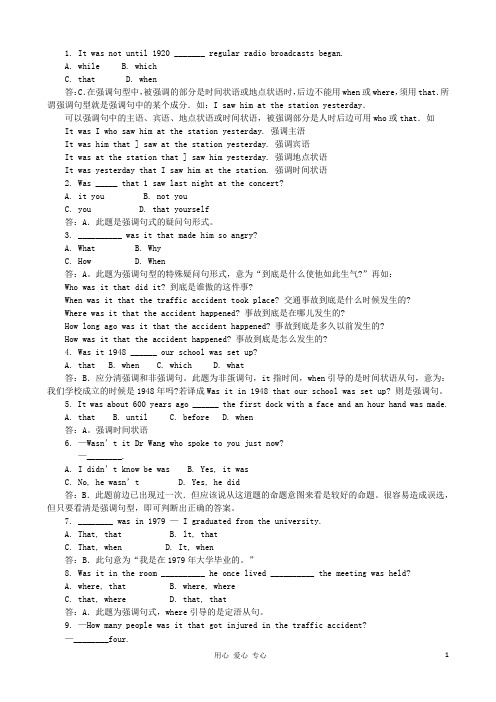
1. It was not until 1920 _______ regular radio broadcasts began.A. whileB. whichC. thatD. when答:C.在强调句型中,被强调的部分是时间状语或地点状语时,后边不能用when或where,须用that.所谓强调句型就是强调句中的某个成分.如:I saw him at the station yesterday.可以强调句中的主语、宾语、地点状语或时间状语,被强调部分是人时后边可用who或that.如It was I who saw him at the station yesterday. 强调主浯It was him that ] saw at the station yesterday. 强调宾语It was at the station that ] saw him yesterday. 强调地点状语It was yesterday that I saw him at the station. 强调时间状语2. Was _____ that 1 saw last night at the concert?A. it youB. not youC. youD. that yourself答:A.此题是强调句式的疑问句形式。
3. __________ was it that made him so angry?A. WhatB. WhyC. HowD. When答:A。
此题为强调句型的特殊疑问句形式,意为“到底是什么使他如此生气?”再如:Who was it that did it? 到底是谁傲的这件事?When was it that the traffic accident took place? 交通事故到底是什么时候发生的?Where was it that the accident happened? 事故到底是在哪儿发生的?How long ago was it that the accident happened? 事故到底是多久以前发生的?How was it that the accident happened? 事故到底是怎么发生的?4. Was it 1948 ______ our school was set up?A. thatB. whenC. whichD. what答:B.应分清强调和非强调句。
高中英语 强调例句练习及答案
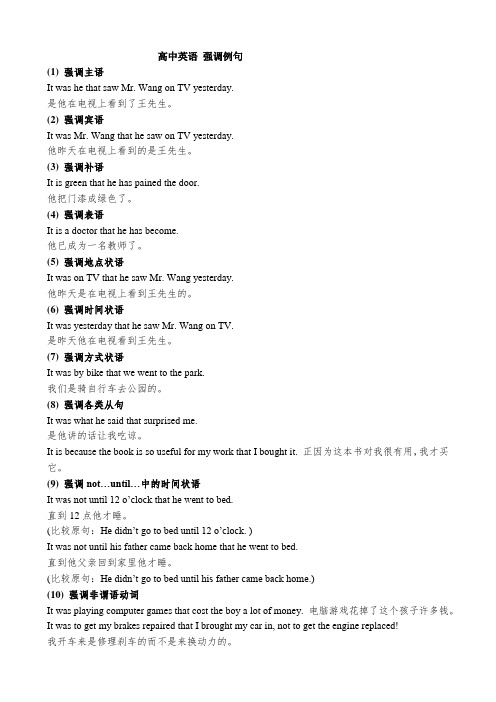
高中英语强调例句(1) 强调主语It was he that saw Mr. Wang on TV yesterday.是他在电视上看到了王先生。
(2) 强调宾语It was Mr. Wang that he saw on TV yesterday.他昨天在电视上看到的是王先生。
(3) 强调补语It is green that he has pained the door.他把门漆成绿色了。
(4) 强调表语It is a doctor that he has become.他已成为一名教师了。
(5) 强调地点状语It was on TV that he saw Mr. Wang yesterday.他昨天是在电视上看到王先生的。
(6) 强调时间状语It was yesterday that he saw Mr. Wang on TV.是昨天他在电视看到王先生。
(7) 强调方式状语It was by bike that we went to the park.我们是骑自行车去公园的。
(8) 强调各类从句It was what he said that surprised me.是他讲的话让我吃谅。
It is because the book is so useful for my work that I bought it. 正因为这本书对我很有用,我才买它。
(9) 强调not…until…中的时间状语It was not until 12 o’clock that he went to bed.直到12点他才睡。
(比较原句:He didn’t go to bed until 12 o’clock. )It was not until his father came back home that he went to bed.直到他父亲回到家里他才睡。
(比较原句:He didn’t go to bed until his father came back home.)(10) 强调非谓语动词It was playing computer games that cost the boy a lot of money. 电脑游戏花掉了这个孩子许多钱。
高考英语新强调句知识点知识点训练含答案(1)

高考英语新强调句知识点知识点训练含答案(1)一、选择题1.- How long is it you picked up your badminton training?- It was not until my finance became better in last December I started the training. A.that; when B.until; that C.since; that D.before; when 2.— Who are making so much noise in the garden now?— _____ the naughty children.A.It is B.They are C.That is D.There are3.It was he said disappointed me.A.that;what B.what;thatC.that;which D.which;that4.It’s not doing the things we like, but liking the th ings we have to do______ makes life happy. A.that B.whichC.what D.who5.It’s not what we do once in a while ______ shapes our lives, but what we do consistently. A.which B.that C.how D.when6.It was at the school _______ was named after a hero ______ he spent his childhood. A.which; that B.where; whereC.that; where D.which; where7.How long do you think the car factory launches a new model?A.will it be until B.it will be beforeC.will it be when D.it will be that8.It is in Canada, where Doctor Bethune was born, the story of the book takes place. A.where B.when C.that D.which9.It was in the school __________ he had studied ___________ he began the important experiment.A.that; where B.in which; whichC.where; that D.where; in which10.It was when we were returning home __________ I realized what a good feeling it was to have helped someone in trouble.A.which B.thatC.where D.how11.At that moment I had a hint of the truth: it is by growing our hearts with love we find our happiness.A.that B.what C.how D.when12.(2016﹒天津卷)You are waiting at a wrong place. It is at the hotel __________ the coach picks up tourists.A.who B.whichC.where D.that13.It was in the factory where he was working ____I met him.A.that B.whichC.where D.in which14.It was not until he came to my support________I freed myself from constant worries. A.that B.when C.which D.so15.— ____ the doctor was murdered?— It was in the art gallery _____ famous paintings were on display.A.Where it was that; that B.Where it was that; whereC.Where was it that; where D.Where was it that; that16.It is _______he often breaks the school rules ______ makes his headteacher unsatisfied with him.A.what; that B.that; thatC.\; that D.that; what17.Was it in June 2016 ______ Shanghai Disney land ______ you have been dreaming of visiting was opened to the public.A.when; that B.that; which C.that; where D.when; where 18.—I don’t know _______ you got to know my telephone number.—Through a friend of mine.A.how was it B.how was it that C.it was how that D.how it was that 19.It was 80 years before Christopher Columbus crossed the Atlantic Zheng He had sailed to East Africa.A.when B.thatC.after D.since20.Fanny asked ________ made that odd-looking little cat so popular.A.what was it that B.wat was thatC.what it was that D.what that was21.It was only when Tom ate Zongzi for a second time to appreciate its deliciousness. A.did he begin B.that he began C.then he began D.had he begun 22.Was it in the beautiful park ___was located at the foot of the mountain ___we first met our foreign teacher?A.which; where B.which; that C.which; which D.that; where23.It is you rather than he who _________ deliver a speech in the meeting tonight.A.Is going to B.are going to C.was going to D.were going to 24.It was not ________ she took off her glasses ________ I realized she was a famous film star.A.when; that B.until; thatC.until; when D.when; then25.What was it ______ brought you two together? Was it your love of music?A.as B.who C.that D.which【参考答案】***试卷处理标记,请不要删除一、选择题1.C解析:C【解析】【分析】【详解】考查连词和强调句型。
高中英语强调句讲解及专练

高考英语强调句强调是有效地进行思想交流的重要手段之一。
人们在交际过程中,为了使自己的思想能被对方恰当的理解,必须加强语气,突出重要的内容,增加对比效果与感情色彩,这时就会用到强调。
强调常见的表现形式如下:一、强调句型为了强调句子的某一成分(通常是主语、宾语、或状语),常用强调句型:It is (was) +被强调部分+that(who)…表示强调的it 在句子中作主句的主语;被强调部分可以是主语,宾语,表语或状语;强调的主语如果是人,that和who都可用。
如:Last night I saw a film in the Youth Palace.强调主语:It was I that (or: who) saw a film in the Youth Palace last night.强调宾语:It was a film that I saw in the Youth Palace last night.强调地点状语:It was in the Youth Palace that I saw a film last night.强调时间状语:It was last night that I saw a film in the Youth Palace.另外,还要注意下面几点:1)在强调主语时,that 后的谓语动词要与被强调者保持人称和数的一致。
如:It is I who am a teacher.2)即使被强调的主语是复数,主句中的谓语动词也用单数。
如:It is they who often help me with my lessons.3)在强调时间、地点、原因或方式状语时,不能用when,where,why或how ,而要用that 。
如:It was because her mother was ill that she didn't go with us.It was only when I reread his poems recently that I began to appreciate their beauty.It was the house that the murder happened.4)在强调not … until 结构中由until 短语(或从句)表示的时间状语时,要用固定的强调句型:It is(was) not until ...that... 注意此时原句的not…until要变成not until ,that 从句中的谓语动词要用肯定式。
高中英语语法基础 强调句型知识点总结归纳讲解(附同步练习)(有答案)
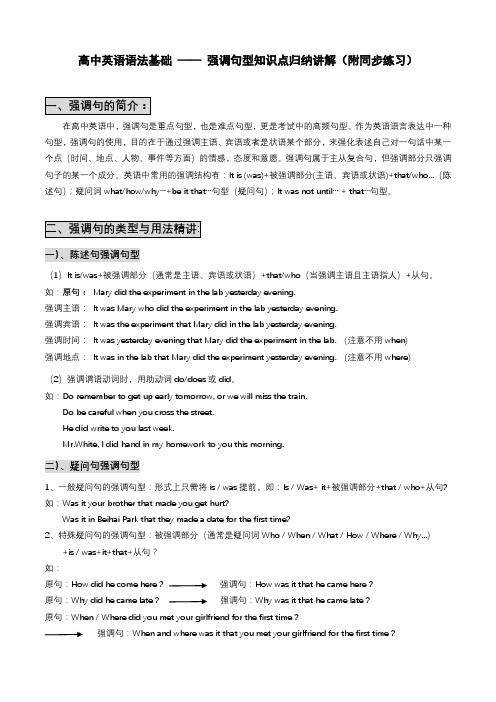
高中英语语法基础——强调句型知识点归纳讲解(附同步练习)在高中英语中,强调句是重点句型,也是难点句型,更是考试中的高频句型。
作为英语语言表达中一种句型,强调句的使用,目的在于通过强调主语、宾语或者是状语某个部分,来强化表述自己对一句话中某一个点(时间、地点、人物、事件等方面)的情感,态度和意愿。
强调句属于主从复合句,但强调部分只强调句子的某一个成分。
英语中常用的强调结构有:It is (was)+被强调部分(主语、宾语或状语)+that/who...(陈述句);疑问词what/how/why…+be it that…句型(疑问句);It was not until… + that…句型。
一)、陈述句强调句型(1)It is/was+被强调部分(通常是主语、宾语或状语)+that/who(当强调主语且主语指人)+从句。
如:原句:Mary did the experiment in the lab yesterday evening.强调主语:It was Mary who did the experiment in the lab yesterday evening.强调宾语:It was the experiment that Mary did in the lab yesterday evening.强调时间:It was yesterday evening that Mary did the experiment in the lab. (注意不用when)强调地点:It was in the lab that Mary did the experiment yesterday evening. (注意不用where)(2)强调谓语动词时,用助动词do/does或did。
如:Do remember to get up early tomorrow, or we will miss the train.Do be careful when you cross the street.He did write to you last week.Mr.White, I did hand in my homework to you this morning.二)、疑问句强调句型1、一般疑问句的强调句型:形式上只需将is / was提前,即:Is / Was+ it+被强调部分+that / who+从句? 如:Was it your brother that made you get hurt?Was it in Beihai Park that they made a date for the first time?2、特殊疑问句的强调句型:被强调部分(通常是疑问词Who / When / What / How / Where / Why...)+is / was+it+that+从句?如:原句:How did he come here ? 强调句:How was it that he came here ?原句:Why did he came late ? 强调句:Why was it that he came late ?原句:When / Where did you met your girlfriend for the first time ?强调句:When and where was it that you met your girlfriend for the first time ?三)、not...until...强调句型1、句型为:It is/was not until+被强调部分+that+从句。
(完整word版)高考英语强调句讲解及练习.docx
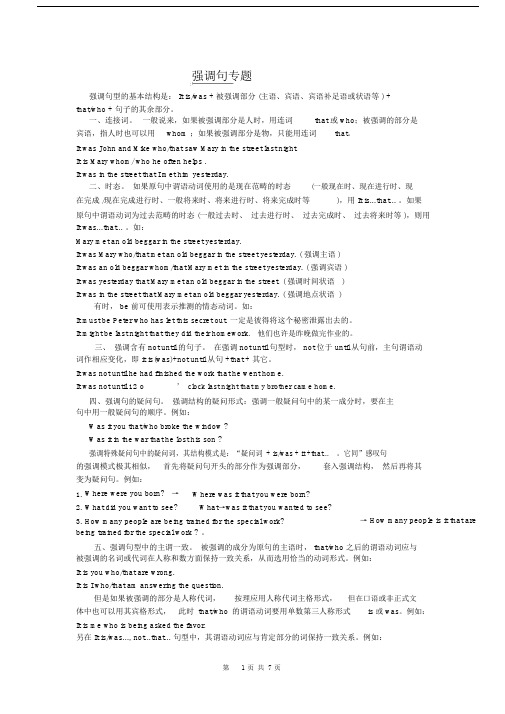
强调句专题强调句型的基本结构是: It is/was + 被强调部分 (主语、宾语、宾语补足语或状语等 ) +that/who + 句子的其余部分。
一、连接词。
一般说来,如果被强调部分是人时,用连词that 或 who;被强调的部分是宾语,指人时也可以用whom ;如果被强调部分是物,只能用连词that。
It was John and Mike who/that saw Mary in the street last night.It is Mary whom/ who he often helps .It was in the street that I met him yesterday.二、时态。
如果原句中谓语动词使用的是现在范畴的时态(一般现在时、现在进行时、现在完成 /现在完成进行时、一般将来时、将来进行时、将来完成时等),用 It is...that... 。
如果原句中谓语动词为过去范畴的时态 (一般过去时、过去进行时、过去完成时、过去将来时等 ),则用It was...that... 。
如:Mary met an old beggar in the street yesterday.It was Mary who/that met an old beggar in the street yesterday. ( 强调主语 )It was an old beggar whom/that Mary met in the street yesterday. ( 强调宾语 )It was yesterday that Mary met an old beggar in the street. ( 强调时间状语)It was in the street that Mary met an old beggar yesterday. ( 强调地点状语 )有时, be 前可使用表示推测的情态动词。
(2021年整理)高中英语新课标强调句型讲解和练习
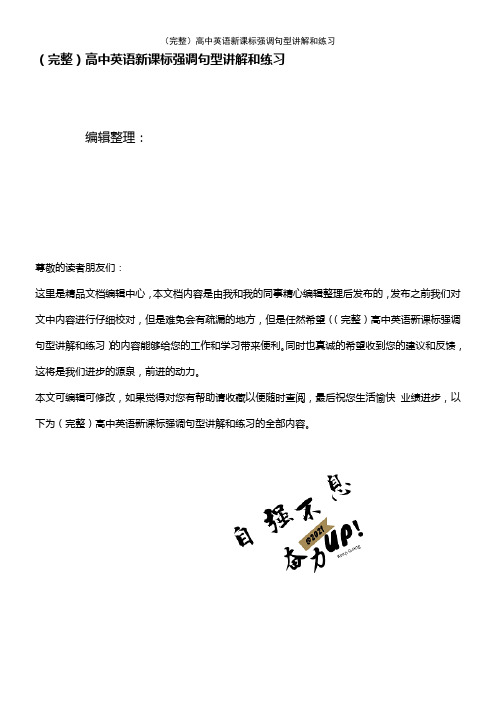
(完整)高中英语新课标强调句型讲解和练习编辑整理:尊敬的读者朋友们:这里是精品文档编辑中心,本文档内容是由我和我的同事精心编辑整理后发布的,发布之前我们对文中内容进行仔细校对,但是难免会有疏漏的地方,但是任然希望((完整)高中英语新课标强调句型讲解和练习)的内容能够给您的工作和学习带来便利。
同时也真诚的希望收到您的建议和反馈,这将是我们进步的源泉,前进的动力。
本文可编辑可修改,如果觉得对您有帮助请收藏以便随时查阅,最后祝您生活愉快业绩进步,以下为(完整)高中英语新课标强调句型讲解和练习的全部内容。
强调句“强调"就是使句子的某一部分比一般情况下显得更加重要.英语表达中,要强调句子的某一成分,一般可用强调句型“It is (was) +that (who) +句子的其余部分”。
It在句中无意义,只起引出被强调部分的作用.被强调的部分指人时,除可用that 外,还可换用who(强调宾语指人时也可用whom)。
使用强调句型时,应注意以下事项:一、去掉强调结构It is (was)… that(who)…后,剩下的词仍能组成一个完整的句子。
这是判断是不是强调句型的关键。
试比较:1。
It is strange that he didn’t come yesterday。
2. It is you and Tom that didn’t come yesterday.1。
It is what you do rather than what you say ____matters. (05天津)A 。
that B. what C. which D. this答案A.这是一个强调主语的强调句型,去掉强调结构,剩下的是What you do rather than what you say matters. 表意完整。
2。
That was really a splendid evening。
It's years ____I enjoyed myself so much。
高考英语语法精讲与精练:并列句、强调句及其它句式
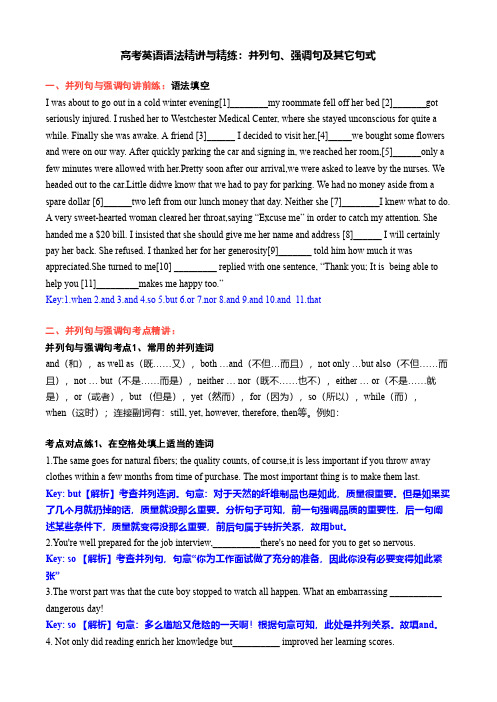
高考英语语法精讲与精练:并列句、强调句及其它句式一、并列句与强调句讲前练:语法填空I was about to go out in a cold winter evening[1]________my roommate fell off her bed [2]_______got seriously injured. I rushed her to Westchester Medical Center, where she stayed unconscious for quite a while. Finally she was awake. A friend [3]______ I decided to visit her,[4]_____we bought some flowers and were on our way. After quickly parking the car and signing in, we reached her room,[5]______only a few minutes were allowed with her.Pretty soon after our arrival,we were asked to leave by the nurses. We headed out to the car.Little didwe know that we had to pay for parking. We had no money aside from a spare dollar [6]______two left from our lunch money that day. Neither she [7]________I knew what to do.A very sweethearted woman cleared her throat,saying “Excuse me” in order to catch my attention. She handed me a $20 bill. I insisted that she should give me her name and address [8]______ I will certainly pay her back. She refused. I thanked her for her generosity[9]_______ told him how much it was appreciated.She turned to me[10] _________ replied with one sentence, “Thank you; It is being able to help you [11]_________makes me happy too.”Key:1.when 2.and 3.and 4.so 5.but 6.or 7.nor 8.and 9.and 10.and 11.that二、并列句与强调句考点精讲:并列句与强调句考点1、常用的并列连词and(和),as well as(既……又),both …and(不但…而且),not only …but also(不但……而且),not … but(不是……而是),neither … nor(既不……也不),either … or(不是……就是),or(或者),but (但是),yet(然而),for(因为),so(所以),while(而),when(这时);连接副词有:still, yet, however, therefore, then等。
高中英语强调句精讲精练(1)

⾼中英语强调句精讲精练(1)强调句句型1. 陈述句的强调句型:It is/ was + 被强调部分(通常是主语、宾语或状语)+ that/ who(当强调主语且主语指⼈)+ 其他部分。
e.g. It was yesterday that he met Li Ping.2. ⼀般疑问句的强调句型:同上,只是把is/ was提到it前⾯。
e.g. Was it yesterday that he met Li Ping?3. 特殊疑问句的强调句型:被强调部分(通常是疑问代词或疑问副词)+ is/ was + it + that/ who + 其他部分?e.g. When and where was it that you were born?4. 强调句例句:针对I met Li Ming at the railway station yesterday.句⼦进⾏强调。
强调主语:It was I that (who) met Li Ming at the railway station yesterday.强调宾语:It was Li Ming that I met at the railway station yesterday.强调地点状语:It was at the railway station that I met Li Ming yesterday.强调时间状语:It was yesterday that I met Li Ming at the railway station.5. 注意:构成强调句的it本⾝没有词义;强调句中的连接词⼀般只⽤that,who,即使在强调时间状语和地点状语时也如此,that,who不可省略;强调句中的时态只⽤两种,⼀般现在时和⼀般过去时。
原句谓语动词是⼀般过去时、过去完成时和过去进⾏时,⽤It was …… ,其余的时态⽤It is …… .⼆、not … until … 句型的强调句1. 句型为:It is/ was not until + 被强调部分+ that + 其他部分e.g. 普通句:He didn't go to bed until/ till his wife came back.强调句:It was not until his wife came back that he went to bed.2. 注意:此句型只⽤until,不⽤till.但如果不是强调句型,till,until可通⽤;因为句型中It is/ was not …… 已经是否定句了,that 后⾯的从句要⽤肯定句,切勿再⽤否定句了。
- 1、下载文档前请自行甄别文档内容的完整性,平台不提供额外的编辑、内容补充、找答案等附加服务。
- 2、"仅部分预览"的文档,不可在线预览部分如存在完整性等问题,可反馈申请退款(可完整预览的文档不适用该条件!)。
- 3、如文档侵犯您的权益,请联系客服反馈,我们会尽快为您处理(人工客服工作时间:9:00-18:30)。
强调句句型1. 陈述句的强调句型:It is/ was + 被强调部分(通常是主语、宾语或状语)+ that/ who(当强调主语且主语指人)+ 其他部分。
e.g. It was yesterday that he met Li Ping.2. 一般疑问句的强调句型:同上,只是把is/ was提到it前面。
e.g. Was it yesterday that he met Li Ping?3. 特殊疑问句的强调句型:被强调部分(通常是疑问代词或疑问副词)+ is/ was + it + that/ who + 其他部分?e.g. When and where was it that you were born?4. 强调句例句:针对I met Li Ming at the railway station yesterday.句子进行强调。
强调主语:It was I that (who) met Li Ming at the railway station yesterday.强调宾语:It was Li Ming that I met at the railway station yesterday.强调地点状语:It was at the railway station that I met Li Ming yesterday.强调时间状语:It was yesterday that I met Li Ming at the railway station.5. 注意:构成强调句的it本身没有词义;强调句中的连接词一般只用that,who,即使在强调时间状语和地点状语时也如此,that,who不可省略;强调句中的时态只用两种,一般现在时和一般过去时。
原句谓语动词是一般过去时、过去完成时和过去进行时,用It was …… ,其余的时态用It is …… .二、not … until … 句型的强调句1. 句型为:It is/ was not until + 被强调部分+ that + 其他部分e.g. 普通句:He didn't go to bed until/ till his wife came back.强调句:It was not until his wife came back that he went to bed.2. 注意:此句型只用until,不用till.但如果不是强调句型,till,until可通用;因为句型中It is/ was not …… 已经是否定句了,that后面的从句要用肯定句,切勿再用否定句了。
三、谓语动词的强调1. It is/ was …… that …… 结构不能强调谓语,如果需要强调谓语时,用助动词do/ does 或did.e.g. Do sit down. 务必请坐。
He did write to you last week. 上周他确实给你写了信。
Do be careful when you cross the street. 过马路时,务必(千万)要小心啊!2. 注意:此种强调只用do/ does和did,没有别的形式;过去时用did,后面的谓语动词用原形。
1. My bike is missing. I can't find ____ anywhere.A. oneB. onesC. itD. that2. —— Who's that?____ Professor Li.A. That'sB. It'sC. He'sD. This's3. ____ was Jane that I saw in the library this morning.A. ItB. HeC. SheD. That4. —— Have you ever seen a whale alive?Yes, I've seen ____.A. thatB. itC. suchD. one5. The color of my coat is different from ____ of yours.A. thisB. thatC. itD. one6. ____ will do you good to do some exercise every morning.A. ItB. ThereC. ThoseD. You7. We think ____ our duty to pay taxes to our government.A. thatB. thisC. itsD. it8. The climate of Shanghai is better than ____ of Nanjing.A. thatB. itC. whichD. what9. ____ four years since I joined the Army.A. There wasB. There isC. It wasD. It is10. How long ____ to finish the work?A. you'll takeB. you'll take itC. will it take youD. will take you11. It was through Xiao Li ____ I got to know Xiao Wang.A. whoB. whomC. howD. that12. It was in the rice fields ____ we had our league meeting.A. whereB. thatC. in whichD. on which13. It was on October 1st ____ new China was founded.A. whichB. whenC. asD. that14. Was it because he was ill ____ he asked for leave?A. andB. thatC. that'sD. so15. Mary speaks in a low voice; ____ is difficult to know what she is saying.A. itB. thatC. soD. she16. It was ____ I met Mr. Green in Shanghai.A. many years thatB. many years beforeC. many years ago thatD. many years when17. ____ is not everybody ____ can draw so well.A. It,allB. It,thatC. There,whoD. There,that18. So ____ that no fish can live in it.A. shallow is the lakeB. the lake is shallowC. shallow the lake isD. is the lake shallow1~5 CBADB 6~10 ADADC 11~15 DBDBA 16~18 CBA英语倒装句(Inversion)主语和谓语是句子的核心,它们之间有两种语序:一是主语在谓语之前称为自然语序(Natural Order);二是主语在谓语之后则称为倒装语序(Inverted Order)。
而倒装语序中又有完全倒装(Full Inversion)和部分倒装(Partial Inversion).***************************************************************完全倒装(Full Inversion):又称"全部倒装",是指将句子中的谓语全部置于主语之前。
此Here’s Tom. 汤姆在这里。
Here comes the bus. 公共汽车来了。
There goes the bell. 铃响了。
Away went the runners. 赛跑选手们跑远了。
【注意】(1) 若主语为代词,则不倒装:Here I am. 我在这儿。
/ 我来了。
Here it comes. 它来了。
Away he went. 他跑远了。
(2) 在there be (stand, lie, live, fly, exist, run)句型中(表示存在):There stood a desk against the wall. 靠墙放着一张书桌。
There are some books on the table. 桌上有几本书.Once upon a time there lived a man known whose name was Beef. 从前有个人名叫比夫。
2. 表示地点的状语或表语位于句首时的倒装为了保持句子平衡或使上下文衔接紧密,有时可将状语或表语置于句首,句中主语和谓语完全倒装: Among these people was his friend Jim. 他的朋友吉姆就在这些人当中。
By the window sat a young man with a magazine in his hand. 窗户边坐着一个年轻人,手里拿着一本杂志。
【注意】在表语置于句首的这类倒装结构中,要注意其中的谓语应与其后的主语保持一致,而不是与位于句首的表语保持一致。
比较:In the box was a cat. 箱子里是一只猫。
In the box were some cats. 箱子里是一些猫。
3. 分词和不定式置于句首的时候倒装有时为了强调,可将谓语部分的现在分词、过去分词或不定式置于句首,从而构成倒装:Buried in the sands was an ancient village. 一个古老的村庄被埋在这沙土之中。
Standing beside the table was his wife. 站在桌旁的是他的妻子。
To be carefully considered are the following questions. 下列问题要仔细考虑。
部分倒装(Partial Inversion):指将谓语的一部分如助动词或情态动词倒装至主语之前,而谓语动词无变化。
如果句中的谓语没有助动词或情态动词,则需添加助动词do, does或did,并将其置于主语之前.比如:1. 含否定意义的词(如never, hardly, seldom, little, few, not until, not, not only, no sooner, no longer, nowhere, by no means 等)置于句首时,其后用部分倒装。
